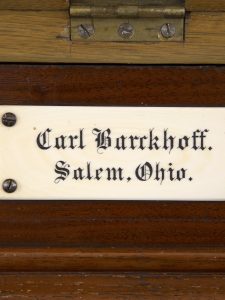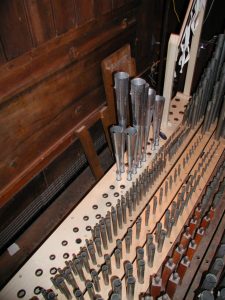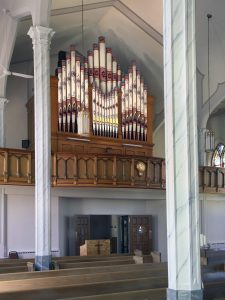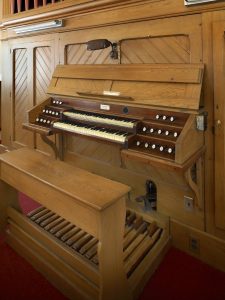St. James Lutheran Church
Logansport, Indiana
2004
We are delighted to have installed a long-prepared-for 8′ Trumpet in the Great of this 1886 Barckhoff organ. The new pipes are exact copies of the only extant original Barckhoff 8′ Trumpet, from St. Joseph’s Catholic Church in Lancaster, PA. The copies were made while the originals were in the hands of our pipemaker for restoration, and the new pipes were voiced side by side with the originals.
The once and future 2’
and other observations from a restorer’s notebook
by Keith Williams
The parish’s 1851 building first housed a reed organ. In 1863, a one-manual organ, pumped with pedals, was purchased for $600. The parish centennial book records that “This organ had several stops. Playing the organ, pumping the pedals, and changing the stops proved too much for the first organist. Therefore, it was necessary to place a man on either side to manipulate the stops. When Mr. Moesta came as teacher, everyone was amazed to discover that he could play without assistance.”
When a new church building was constructed, a Mr. Barber installed a “large and ornamental organ at a cost of $3,300.” This instrument was destroyed by fire when the church burned in 1883. Research has thus far not turned up any information about this builder.
The church lost no time in making plans to rebuild the church and replace the organ. On May 13, 1883, Teacher Moesta was given permission to be absent from school for one day to go to Indianapolis to try out a new organ. (Was this perhaps Thomas Sanborn’s 1883 instrument for what is now Lockerbie Central United Methodist Church, now in its third home at St. Mark’s United Methodist Church in Bloomington, IN?) The church authorized Teacher Moesta and a Mr. Engelbrecht as the organ committee on September 9, 1883, empowering them to purchase a new organ for not more than $2,500. Perhaps Barckhoff was selected to build the organ because he could deliver it quickly. Newspaper reports confirm that the organ was installed by the end of that same year, when the rebuilt church was dedicated!
The organ was originally furnished with a water motor, which when the pressure was low or the organist was playing loudly, had to be supplemented by the work of the young boys of the congregation manning the pump handle. Parish files record the installation of an electric blower in 1911.
The Barckhoff organ at St. James Lutheran Church has provided some interesting examples of the issues raised in documenting and restoring an older pipe organ. This writer first saw this delightful organ in August, 2003. The appearance and sound of the organ were wonderful; the mechanical condition somewhat less so. The organ’s façade had been repainted (replicating the original appearance). The original pipework was almost completely intact. The original double-rise reservoir was in place minus its feeder bellows.. The original pumping mechanism is otherwise intact, and the pump handle is still stored within the organ. Without the feeders, the reservoir sagged noticeably in the center.
Following water damage in 1996, several modifications had been made. The original wooden mechanical action parts were replaced from the vertical stickers at the keyboard, with plastic squares and aluminum trackers. The Pedal windchests received new plywood top tables. Great, Swell and Pedal toeboards were modified to allow the installation of plastic slider seals; new phenolic sliders were installed, and slider seal rings were installed on the windchest top tables. The Great windchest was “replicated.” The new windchest was made to the original dimensions and reused the original pallets. However, the pallet springs for the extremely long (14-1/2”) pallets were relocated to the center of the pallet from their original location. The pallets had almost certainly originally been glued down at the tail, but in the reconstruction they were not. The result was a windchest extremely prone to ciphers. Previous attempts to solve this problem included replacement of the felt & leather pallet covering with leather backed with foam!
Eventually, Buzard Pipe Organ Builders was able to return the pallet springs to their original location, and the pallets are now retained at the tail by a small spring, which has eliminated the persistent ciphering. Future plans call for the reinstallation of wooden trackers and squares to return the playing action to its original condition (eliminating the “sponginess” endemic to aluminum trackers installed in this fashion.)
Space had been provided from the outset on the Great windchest for the installation of an 8’ Trumpet. In 2004 a donor came forward to provide the funds for its long-anticipated installation. (Not many prepared-for stops arrive after 121 years!) A unique set of circumstances allowed as close a copy as possible to be made. The only known unaltered Barckhoff reeds (Great Trumpet and Swell Cornopean) exist in the 1891 instrument at St. Joseph’s R.C. Church in Lancaster, PA (visited during the 2003 OHS Convention). In 2004, Columbia Organ Works delivered these reeds to be restored at Eastern Organ Pipes in Hagerstown, MD. While the original pipes were at Eastern, an exact copy was made (because of scaling differences in the two organs, the Swell Cornopean was copied for Logansport. Other than being of a slightly smaller scale, it is otherwise identical to the Great Trumpet). The new pipes were voiced side by side with the originals in the presence of Buzard Service Department Director Keith Williams, with the new pipes tested with both new and original tongues as well. Many thanks to Larry Pruett of Columbia Organ Works and Rick Morrison of Eastern Organ Pipes for their cooperation in this historic endeavor.
The wind pressure of the organ is 3” water column, consistent with all other Barckhoff organs known to this writer. The pitch of the organ is presently A-448 at 78 degrees F. This is certainly higher than when the organ was originally installed. Examination of pipework during cleaning and repairs revealed that several stops in the organ have been loudened (in 1912?), including the Pedal 16’ Sub Basse, Swell 8’ Diapason, 8’ Rohr Flute, 4’ Harmonic Flute, Great 16’ Bourdon, 8’ Open Diapason, 8’ Melodia, 4’ Octave, 2’ Fifteenth, and the unison ranks in the Great III Mixture. Toeholes have been opened in metal pipes, and regulating plugs have been completely removed from the feet of wooden pipes. Whoever undertook this did not perhaps realize that the pipes would no longer tune properly. At present, many of the scrolls on the metal ranks are almost completely rolled up, and stoppers on many wooden pipes just barely rest in the pipes, even at the present very high pitch.
Etched onto the block of the CC pipe of the Swell Oboe is the inscription “revoiced 1912.” It is clear that the thrust of that 1912 work was to make the Oboe as loud as possible, perhaps to compensate for the lack of the still-uninstalled Trumpet. Shallot openings were increased, and the resonators were trimmed, in the bass to the point of almost eliminating the regulating scrolls. Restoration of this stop at the Buzard factory in 2007 included soldering up the original scrolls and cutting new ones of the same dimension as the originals. Lifting lids were installed for pipes 1-17 to allow for the pipes to again properly tune and regulate.
Perhaps the most puzzling item in the specification is the (tenor C) Swell 2’ Principal. The stopface is not original, and the present pipes are newer than any other pipes in the organ (except the Trumpet.) A more usual stop in a Barckhoff Swell division of this size might have been a (tenor C) 8’ Aeoline. This would often have been located adjacent to the (ever-present) Salicional, sharing its stopped bottom octave as does the Diapason that of the Rohr Flute. In fact it appears that the Salicional toeboard was originally prepared for this, as there are (plugged) holes in the front side of the toeboard similar to those in the Diapason and Rohr Flute toeboards. (Perhaps this indicates that this was an organ already under construction in the factory when the contract was signed, which was modified in the process of construction in order to provide the speedy delivery discussed above.) However, the location of the 2’ stop on the Swell windchest is not adjacent to the Salicional, but further forward between the Oboe and the Harmonic Flute, and there are no holes drilled in the side of the 2’ toeboard. (The 1886 Barckhoff organ at St. Mary’s Catholic Church in New Albany, IN {OHS Citation #270} contains an original 2’ stop in the Swell.) The rackboard and top of the toeboard are drilled out for the stop to be full compass, and there is additional newer felting in the rackboard for the present pipes.
Research in the church records and removal of the toeboard provided some clues to the history of this stop. The parish centennial book records as follows. “In 1946 the organ was cleaned and a new stop added. This stop, the “Aceline” (sic), supplies a very soft tone. The total cost of cleaning and improving the organ was $650.” Parish records indicate that the contract was awarded to Mr. Sauter and Mr. Collier. Mr. Collier was also selected as organ tuner and repair man at this time. When this writer first saw the organ, some few pipes of an Aeoline were lying within the base of the organ. These were older pipes, of a different metal composition than the other Barckhoff strings, showing clear evidence of rescaling for installation in Logansport. The Aeoline had a relatively brief tenure, and a spotted metal tenor C 2’ of modern construction (pipes stamped “Prin”) is presently in residence. There are in fact holes in the windchest top table down to bottom C. When a capboard was glued to the underside of original toeboard to allow for the installation of slider seals, holes were not drilled upwards to connect to the toehole for the bottom octave. This may perhaps have been due to the presence of some relatively large splits in this area of the top table, which were beyond the capacity of the people involved to repair at the time. Instead, the toeboard was left sealed for the bottom octave, and the bottom 12 pipes (if they existed at the time) were discarded. Work in 2007 including sealing of the splits in the top table, so that a bottom octave for this stop can eventually be reinstalled. It appears, then, that this organ was originally shipped with a 2’ stop, replaced by an Aeoline in 1946, which was in turn supplanted by another 2’ stop (in 1996?).
Work completed by Buzard Pipe Organ Builders from 2004-2007, in addition to installation of the 8’ Trumpet and restoration of the 8’ Oboe, has included:
Cleaning of all pipework, taking up all toeboards and replacing missing and broken slider seals as necessary.
Repacking of stoppers on all stopped wood pipes.
Installation of tuning flaps on the treble of the Pedal 16’ Open Diapason
Replacement of missing pipes in Dulciana (A58), 4’ Flute d’Amour (35 & 36), III-rank Mixture (various).
Repairs to several tuning scrolls, and installation of some tuning slides (without removal of scrolls) where the pipes would not otherwise tune flat enough at present.
Repairs to flue pipes as necessary.
Slight softening of Swell 4’ Harmonic Flute 17-24 to allow the pipes to tune flat enough.
Installation of support blocks beneath center of reservoir to eliminate sag.
Releathering of reservoir escape valve.
Repairs to Tremulant wind line and (tubular pneumatic) stop action
Many thanks to Rev. Marvin Hinkle, Organist Ann Rehm Hansen, and Administrative Secretary Darla Ward, as well as the rest of the parish of St. James. They are true champions of this fine instrument.
St. James Evangelical Lutheran Church, Logansport, IN
Carl Barckhoff, Salem, Ohio – 1883
Ongoing restoration by Buzard Pipe Organ Builders
GREAT 58 notes, 1 slider chest in “N” configuration (1st 8 pipes of #-side offset)
16’ Bourdon 58 stopped wood; pine w/walnut caps; 1-44 FHWS in cap; 45-58 1 RHWS
in center of cap. Caps flush w/block 1-24; caps set below block 25-58
W D c.u. 1-8 on offset toeboards at sides of windchest, winded via zinc tubing
1 127 x 184 37 29 x 34 18
13 73 x 89 37 49 17 x 20 9.5 (measurements in mm)
25 47 x 55 30 58 11 x 16 6
8’ Open Diapason 1-17 zinc in façade, slide tuners w/ wooden knob handles inside pipe;
Toeboard is attached directly to façade impost
18 engraved “42 CB Op Dia”
D m.w. c.u. 18-58 sm with scrolls, nicking in languids only
1 165 150 40 37 33 26 8
13 100 85 23 49 20 16 4.5
18 77 58 17 58 12 10.5 3
25 56 42 13
8’ Melodia 1-12 sw, 13-58 ow
pine w/walnut caps, caps set below block
1 83 x 94 45 25 40 x 48 11
12 50 x 63 25 37 25 x 30 8
13 60 x 72 17 49 13 x 17.5 5
58 10 x 13 3
8’ Dulciana 1-12 grooved from Melodia; 13-58 sm, scroll-tuned, ears 13-36
13 engraved “55 CB Dul”, nicking in languid & lower lip
13 52 32.5 10 49 10.5 7.5 2
25 32 20 5.5 58 8 6 1.5
37 19 12.5 3.5
8’ Viola di Braccio 1-17 zinc, 18-58 sm, ears 1-43, scroll tuned, box beards 1-36
18 engraved “51 CB Gamba”, nicking in languid & lower lip
1 110 82 22 37 21 18 6
13 66 49 14 49 12.5 10 3
25 38 30 9 58 9 7 2
4’ Principal 1-5 zinc, 6-58 sm, slotted 1-36, originally cone tuned 37-58, ears 1-36
5 engraved “56 CB GR PR”, nicking in languid only
1 77 55 19 37 17.5 14 4.5
13 51 39 12 49 10.5 8 3
25 30 24 7 58 7 5 1.5
4’ Flute d’Amour 1-34 sw (originally 1-36?), pine w/walnut caps
1-17 2 FHWS in cap; 18-34 1 RHWS in center of cap
35-58 sm (35 & 36 replacements 2007 Buzard)
1 46 x 56 19 37 22 16 4
13 29 x 35 17 49 10 8 3
25 17 x 20 9 58 8 6 1.5
3’ Twelfth 58 sm, slotted 1-17, 18-58 originally cone tuned, ears 1-27
1 engraved “62 CB 12”, nicking in languid only
1 78 50 14 37 15 10.5 3
13 39 30 10 49 8.5 6.5 1
25 23 18 5 58 6 5
2’ Fifteenth 59 sm, slotted 1-12, originally cone tuned 13-58
1 engraved “69 CB 15”, nicking in languid only
1 48 39 12 37 10 8 3
13 29 22.5 7 49 7 5 1.5
25 17 13.5 4 58 5 4
III Mixture all 3 ranks 1-58 sm, 1-12 of Rank I originally cone tuned
1 of each rank engraved – I “70 CB Mix;” II “65 CB Mix;” III “70 CB Mix”
25 of Rank I engraved “68 CB Mix”
1-24 = 15,19,22; 25-43 = 12,15,19; 44-58 = 8,12,15
(Second break originally at F42?)
Rank I Rank II Rank III
1 46 35 10.5 29 23 7 28.5 21 6
13 27 21 7.5 18 14 4 17 13 3.5
24 17.5 13 3.5 10.5 8 2 11 7.5 2.5
25 17 14 4 16 13 4 10 8 2.5
37 11 7.5 2 9 7.5 1.5 7 5 1.5
42 9 6 2 8 6.5 1.5 6 4
43 12 10 3 8.5 6.5 8 5
49 9 7 1.5* 6.5 4.5 7 5
58 6.5 5 5 4 4 3
*Buzard replacement 2007
8’ Trumpet installed 2004; 1-49 reeds, zinc & sm; 50-59 slotted sm flues
CCC block stamped “EOP E746”
Harmonic from C#38-C49; Overlength boots 21-32
Tapered shallots, tapered shallot openings
1 120 13 95 25 75 37 66 38 65 49 57 50 14 11 3 58 10.5 7.5 2.5
SWELL 58 notes, 1 slider chest in “N” configuration (1st 8 pipes of #-side offset)
Balanced Swell pedal, on right side of knee panel, 12 vertical shutters
8’ Swell Diapason 1-12 grooved from Rohr Flute, 13-17 zinc, 18-59 sm, slotted
18 engraved “43 CB Sw Op”
Parallel nicks in both languid and lower lip (spaced 2mm at C13)
13 90 70 19 49 18 14 4
25 54 41 12 58 12 10 2
37 32 25 7.5
8’ Rohr Flute 1-58 sw (no holes in stoppers), pine with walnut caps
1-36 FHWS in cap; 37-58 1 RHWS in center of cap.
Caps flush w/block 1-24; caps set below block 25-58
Light nicking in flue, none in cap
1 70 x 90 32 37 21.5 x 28.5 10.5
13 55 x 66 27 49 15 x 20 5
25 35 x 43 18.5 58 12 x 16.5 3.5
8’ Salicional 1-12 sw, 13=58 sm spotted, 13-58 nicking in languid only
13 engraved “65 CB Sal”
1-12 pine with oak caps, set flush with block, nicking in block only
1 65 x 74 30 25 31.5 24 7
12 41 x 48 21 37 19 15 3.5
13 53 41 13 49 11 8 2.5
58 7.5 5.5 2
4’ Fugara 1-5 zinc, 6-58 sm, slotted, ears 1-36
6 engraved “60 CB Fuga”
49-58 originally cone tuned, nicking in both languid & lower lip
1 75 47 14 37 14 10.5 3
13 44 29 9 49 9 7 1.5
25 36 19 6 58 6 4.5
4’ Harmonic Flute 1-5 zinc, 6-58 sm, harmonic 35-58, slotted
ears 1-36, nicking in both languid and lower lip
arched cutups (measurement to center of cutup)
1 68 43 16 37 22 17 7
13 53 38 14 49 14 11 3
25 36 26 12 58 9 7 3
2’ Principal (replacement stopface)
13-58 spotted metal
Pipes stamped “PRIN”, slide tuners
13 25 13 6 49 8 8 2
25 19 15 4 58 6 6 1.5
37 11 11 3
8’ Oboe zinc & sm, 1-49 reeds, 50-58 sm slotted
Resonators full length, 1-8 knuckle mitered
Tapered shallots, tapered shallot openings (widened 1912)
New tongues & lifting lids (1-17) Buzard 2007
1 13 25 37 49 50 14 10 3
Diameter 75 65 48 41 34 58 9 7 2.5
Stem length 708 343 155 54
Bell length 357 165 85 60
PEDAL 27 notes, two chromatic slider chests (1-10 & 11-27)
Chests arrayed at right angles to manual chests
16’ Open Diapason 1-27 open wood
caps flush with block, no nicking
1-18 extended (wooden) lower lip
1 178 x 228 59
13 102 x 127 50
25 56 x 75 31
16’ Sub Basse 1-27 stopped wood
Caps flush with block, no nicking
1-12 wooden ears
1 136 x 185 59
13 84 x 113 43
25 52 x 69 27
8’ Violoncello 1-17 zinc, 18-27 sm, ears 1-27, narrow scrolls
nicking in languid only
18 engraved “46 CB Cello”
1 130 88 29
13 73 54 14
25 43 34 10
Double-rise reservoir, feeder bellows have been removed.
Circular wind indicator in nameboard – “J.E. Treat, Boston Pat. June 5, 1877”
Spencer Orgoblo #9140 2 HP, 1200 rpm, 4” wp
“Fans 25” 25” ”
Trumulant to Swell (pneumatic dump), with tubular pneumatic stop action
Coupler Gt. to Ped.
Coupler Sw. to Ped.
Coupler Sw. to Gt.
Flat, non-radiating pedalboard
Unlabeled combination pedals
Great to Pedal
Great Piano
Great Forte
Bellows Signal (deactivated)














